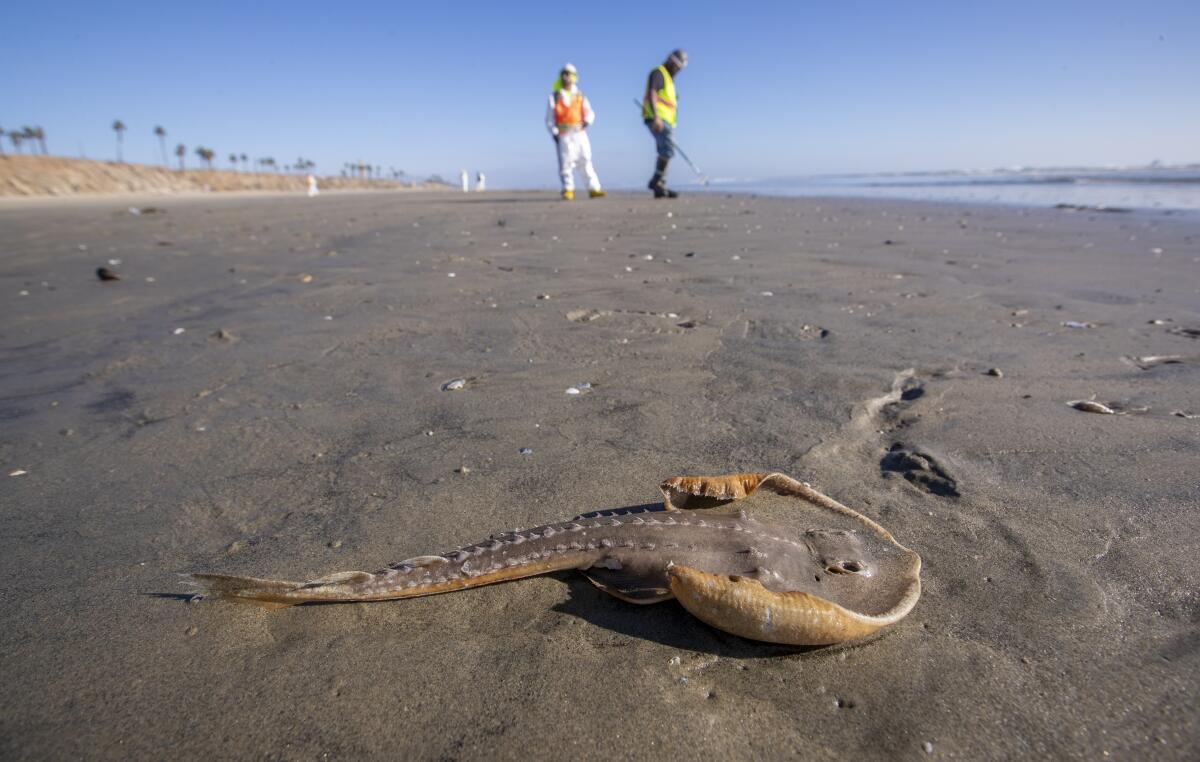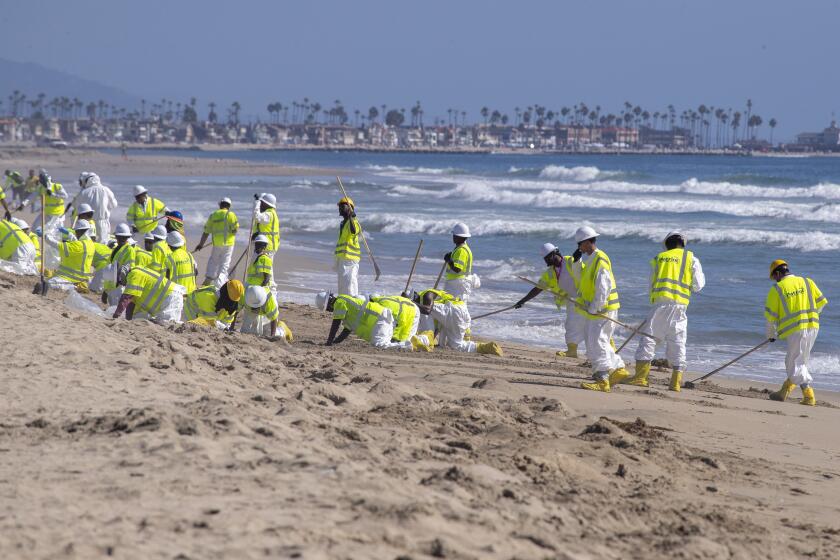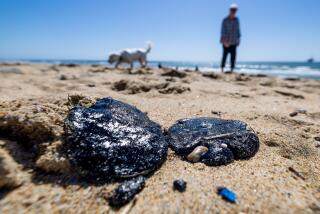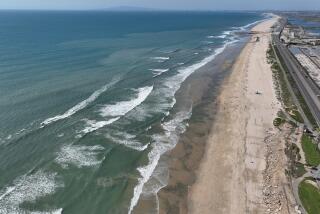Changing weather raises fear that O.C. oil spill could reach more coastal areas

- Share via
Winds forecast to blow over the Orange County coast beginning late Thursday may push parts of the oil slick from a massive spill onto shore, threatening ecologically sensitive areas.
The oil that leaked from a broken pipeline about four miles offshore has been creeping slowly south in the last three days.
Crews are working to protect the coastline by deploying booms and reinforcing berms. One oil slick is floating off Newport Beach and Huntington Beach, and another is in motion near San Clemente.
A massive oil spill off the Orange County coast has fouled beaches and killed birds and marine life
The storm, which could bring a touch of rain late Thursday through Friday, is expected to bring winds of up to 20 mph, potentially creating choppy oceans.
A storm that passed through the region Monday, bringing heavy rain, lightning and swelling tides, didn’t seem to shift the spill significantly, though it did halt cleanup work for more than 12 hours.
“We are closely watching the weather patterns as it relates to the oil slick,” said Newport Beach city spokesman John Pope. “Of course, it’s our hope that it gets pushed farther out to sea, where the cleanup is easier.”
Huntington Beach officials say they’re working closely with meteorologists to get ahead of potential problems.
Experts say wind, waves and tides can all steer the slick, which is a thin layer that sits on the surface of the ocean.
“I think the likelihood of oil making it ashore is going to increase as we get some of these storm events coming in,” said Eric Terrill, an oceanographer at Scripps Institution of Oceanography.
Deborah Sivas, director of the Environmental Law Clinic at Stanford Law School, said the Southern California coastal current generally moves north to south, but shifting winds could push oil in other directions.
“How big the spread is kind of depends on the forces of nature that we don’t have a lot of control over,” she said.
The biggest risk to surfers, swimmers and wildlife is big sticky chunks of contaminants in the water, Sivas said.
Cleanup efforts and natural dissipation could clear up most of the chunks within a few months, she said.
But sensitive coastal wetlands, including the Talbert Marsh, could suffer for much longer.
“This is what happens — it’s an inherent risk of offshore oil development,” Sivas said. “You’re going to have these pipelines rupture, or blowouts at the platform ... It’s going to be inevitable until we stop doing drilling out there.”
In Laguna Beach, small globs of oil and tar continued to wash ashore Wednesday.
However, the city, which is home to sensitive marine habitats, has managed to avoid widespread oiling that has plagued cities to the north.
“Knowing we have that volume of oil off the coast, the potential for it to come to shore still exists, especially since we’re going to have a change in weather coming up,” said Kevin Snow, chief of marine safety for Laguna Beach.
By the end of the week, officials expect to have 1,500 workers cleaning oil from beaches and offshore areas.
On Wednesday, the contingent numbered roughly 300 workers from Newport Beach to Dana Point, said Rebecca Ore, commander of the U.S. Coast Guard Sector Los Angeles-Long Beach.
Under gloomy skies at Talbert Marsh, the workers used grimy rakes to search for oil stuck against walls and rocks. Pelicans perched nearby, and a trash bin was filled with plastic bags of oil.
John Villa, the executive director of Huntington Beach Wetlands Conservancy, said the crews had successfully cleansed oil from the water.
The main focus now, he said, is the rocks lining the 25-acre restored wetlands.
The rain that moved through the region Monday wasn’t a problem, but the upcoming winds are a concern because they could push oil against the rocks. The workers will scrub them with dish detergent, biodegradable materials and steam.
The U.S. Coast Guard is continuing to investigate whether a large commercial ship put down its anchor in the wrong location, damaging the Amplify Energy pipeline and triggering a spill of an estimated 144,000 gallons, an official familiar with the investigation told The Times this week.
Officials on Wednesday did not provide any additional information about the investigation.
There are growing questions about how the oil spill was handled in its initial hours.
Martyn Willsher, president and chief executive of Amplify Energy Corp., said during a news conference Wednesday that the company first learned of the leak at 8:09 a.m. Saturday. He said oil was not being pumped at that time.
“We are conducting a full investigation to that and working with ... regulators to see if there was anything that should have been noticed,” he said.
In a 13-page letter sent to Willsher on Tuesday, U.S. Department of Transportation regulators said that employees in a control room received a low-pressure alarm “indicating a possible failure” at about 2:30 a.m. Saturday. It took more than three hours for the pipeline to be shut down, the letter said.
Officials say the pipe is no longer leaking.
Willsher denied that anyone at the firm was alerted to the leak at 2:30 a.m. He did not elaborate further, saying facts would emerge during the investigation.
On Tuesday night, the Coast Guard launched an investigation into the spill that will focus on how it occurred and how both the agency and the oil company responded, said Capt. Jason Neubauer, chief of investigations.
“We will look at all aspects of the incident,” Neubauer said.
Oil from the pipeline leak has been detected as far south as San Clemente, and officials caution that it could continue to move farther south in the days ahead.
More than 5,000 gallons of oil had been removed from the water as of Wednesday, but light oil remains along roughly 15 miles of shoreline. Officials deployed 11,360 feet of boom to protect the coast, according to the Coast Guard.
On Wednesday morning, anti-pollution vessels could be seen off the coast of Newport Beach, Dana Point and San Clemente.
At least 19 oiled birds have been recovered, officials said. Two of them — an American coot and a western gull — have died.
Four oiled snowy plovers, a federally threatened bird species, have been found in Huntington Beach, officials said.
On Wednesday morning, Lorraine Aguilar stared at the gray-green waves just north of Bolsa Chica State Park with tears in her eyes.
She was worried about the pod of dolphins she had just seen and whether they would eat fish from the contaminated water. She surfs there several times a week. The parking lot, usually crowded with fellow surfers, was empty.
“It doesn’t have to be like this,” Aguilar said. “I hope it’s a wake-up call for all of us as we get progressively louder and louder messages from the Earth.”
Elsewhere on the beach, a team of four people from the Coast Guard and other agencies slowly paced the sand, taking notes and snapping pictures.
They were looking for tar balls and hadn’t yet seen any, one man said.
The absence of visible contamination was little comfort to Aguilar, a former chemical engineer.
“It’s all the stuff we can’t see that scares me,” she said. “This will have impacts for years to come as it works through the food chain.”
Times staff writer Hayley Smith contributed to this report.
More to Read
Sign up for Essential California
The most important California stories and recommendations in your inbox every morning.
You may occasionally receive promotional content from the Los Angeles Times.














